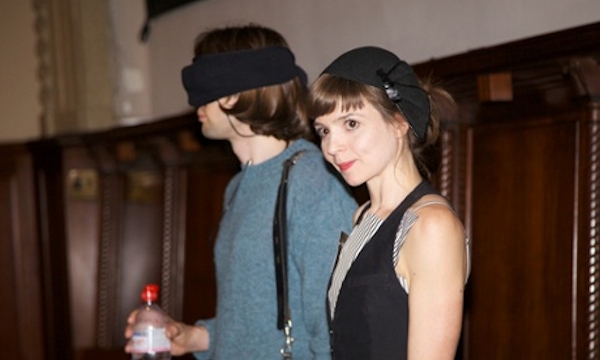[“In My Shoes experiments with alternative methods of communication. My aim is to put audiences as close to being in the shoes of a stranger as I can, I use virtual reality software, touch, taste, sound & smell to make it as true to life as possible.”… This is from The Guardian, where the story includes an additional picture.]
[Image: Jane Gauntlett leads someone wearing audio-visual and more conventional props through a performance of In My Shoes in New York. Photograph: Amy Hart]
Virtual reality theatre puts experience of brain damage centre stage
Jane Gauntlett’s brain injury forced her to rethink her work, resulting in an intimate mix of storytelling and wearable tech
Fred McConnell, theguardian.com,
Wednesday 15 January 2014
In 2007, Jane Gauntlett was planning for a career in theatre when she was violently mugged and fell into a coma for three weeks. She suffered a traumatic brain injury (TBI), the long term legacy of which includes epileptic seizures and short term memory and communication problems.
“When I woke from the coma I had no idea how severe the injury was. I was adamant that I was to become a freelance theatre producer,” says Gauntlett, who had completed the Royal Court Theatre’s Young Writers Programme while working previously for mental health charities. Initially, she stayed on track, gaining experience with interactive theatre makers at Battersea Arts Centre and producing shows in Edinburgh, London and Margate.
However, work was disrupted by epilepsy. Worse than the seizures themselves was the alarmed reaction of colleagues, and this was compounded by the humiliation of not being able to remember and communicate as freely as she once had during the creative process.
Life will never be the same
The first step toward accepting her life post-injury was to volunteer as a mentor for young people with similar issues. She worked to facilitate understanding between those she mentored and those who could in no way relate to the daily experience of TBI, which can be frustrating and scary. Those whose injuries leave no physical trace face the biggest challenge, since their problems are so easy for others to overlook. Gauntlett says the young people had to accept that life would never be the same because “communication with families, friends and strangers was often tough.”
It was this imperative for empathy between those with and without brain injuries that gave Gauntlett her route back into theatre. But to achieve her goal, she had to look beyond the spacial and relational conventions of performance. The result was a piece called In My Shoes which lacks anything one might recognise as actors or an audience and is also non-site specific. In fact, the immersive and single-user experience relies mostly on technology.
Life becomes theatre with the aid of technology
The piece recreates the producer’s own disorientating experience of waking up in Slough after a seizure, with no idea how she got there. The audience – or rather the one person experiencing the show – is put “into Gauntlett’s shoes by wearing Vuzix 920 Eyewear, wrap-around video glasses, and earbuds connected to an iPod Touch which deprive them of their own, familiar senses. Virtual reality takes over and is augmented further by the manipulation of touch, taste and smell, though exactly what happens should probably be saved for the performance itself.
“We have our eyes peeled for technology that will enhance our experiences – we want to keep up to date,” says Gauntlett. “In My Shoes experiments with alternative methods of communication. My aim is to put audiences as close to being in the shoes of a stranger as I can, I use virtual reality software, touch, taste, sound & smell to make it as true to life as possible.”
The success of the first incarnation – reactions run the gamut of emotion but are never underwhelmed – led to the evolution of the piece. Gauntlett formed a collective called Sublime and Ridiculous, to share the work of exploring a variety of complex, delicate or controversial subjective realities. They have so far put hundreds of willing participants into the shoes of people with post-traumatic stress disorder, bi-polar disorder and stroke, as well as those of a paramedic and a trans-gender person. They have plans to adapt the piece and its technology to explore the perspectives of an astronaut, a politician, a dominatrix and a murderer.
Though Gauntlett had no prior experience in the field, technology is now integral to her work: “I am fascinated by how quickly things are evolving and have my eyes peeled for new inventions. In My Shoes is an ever-expanding collection of audio and audio-visual experiences and I am keen to expand it, and for it to evolve using cutting edge technology as it becomes available.”
Technological innovation is part of theatre’s future
Despite such a unique genesis and production, she is quick to point out that the symbiosis of theatre and tech is common in contemporary performance. “Interactive theatre plays a large part in the fringe scene,” she says, while elsewhere, technology is used to deepen understanding in other specific contexts: “High tech Kabuki theatre in Japan uses portable monitors [for the audience to read] subtitles in order to better understand an artform that is often difficult to comprehend.”
As well as illuminating intensely personal experiences, Gauntlett hopes such advances will lead to more international collaboration and theatre that is accessible to much broader demographics. However, she says: “I don’t think theatre’s survival and relevance depends on embracing technological advances.” The point is there is room for everything, and technology-driven theatre will gain momentum as technology becomes ever more integral to people’s daily lives.
Such innovation, she says, “is sometimes frowned upon by critics. However, if the work is good it shouldn’t matter.”
—
Sublime and Ridiculous will perform In My Shoes at Battersea Arts Centre, London on 8 February 2014, as part of Freshly Scratched
